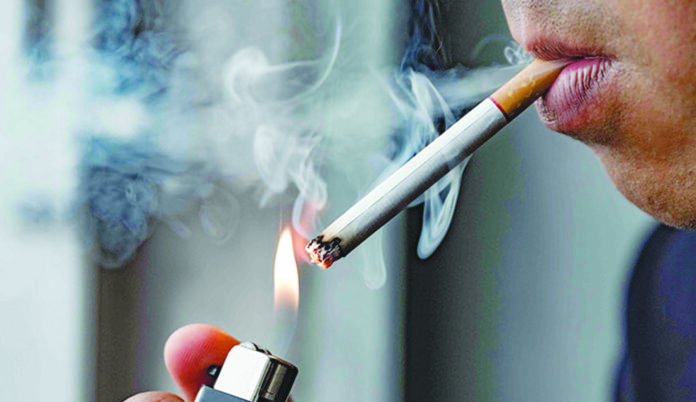That smoking is harmful to health is a universal fact and a very common statement. But ironically in reality it is dealt otherwise in our society, and the number of smokers is increasing equally and rapidly every day and every year across the country. Smoking is the first ladder that elevates someone to the addiction of heavy drugs ultimately.
It is the most common and traditional form of tobacco used worldwide. However, it has been renewed with other forms like cigars, heated tobacco, pipe tobacco, shisha, hookah and so on. Tobacco use is very common among all age groups, nevertheless, it is penetrating quite speedily among adolescents and youth. The age group that falls between 25 to 44 is the most reported cohort involved in smoking cigarettes.
The UN says that currently more than 1.3 billion of the world’s population smoke cigarettes and a major portion is the young generation. The organization further affirms that nearly five trillion cigarettes are consumed each year, causing more than eight million deaths which include an estimated 1.3 million non-smokers who are exposed to second-hand smoke or are passive smokers. In addition to this, smoking causes nearly $2 trillion loss each year to the world economy.
While looking into the gravity and severe consequences of smoking trends the UN envisaged the situation as traumatic. Consequent upon this, a resolution was passed and 31 May was declared as the world “No Tobacco Day”. The purpose of celebrating the day was to inform the public about the danger of using tobacco, drawing attention to the business practices of tobacco companies and the efforts of WHO for fighting the tobacco epidemic and the preventable deaths and diseases it causes. The statement further explained what the people around the world could do to claim their right to health and healthy living and to protect future generations. In addition to this it emphasized to stop illicit trade of tobacco, ban tobacco advertising, promotion and sponsorship, propagate it as anti-environment and moreover to grow food not tobacco.
Tobacco users are found everywhere in the world. No corner of the world is free from smokers. However, their intensity is found more in the low and middle income countries. Pakistan is one of these countries, where the statistics regarding smoking addicts is growing. Though these smokers acknowledge that cigarette smoking is injurious to health and a financial loss; and they are willing to quit it as the research indicates, but in reality, their number is increasing regrettably. Youth is the most important segment of a society. They are the future of the country. So, they should be rescued at all costs from smoking habits.
The prominent causes behind using tobacco among the young cohort is the perceived accessibility and the unchecked prevalence of cigarettes. The studies have outlined that the company, society, peer smokers, electronic smoking (e-smoking) and different flavours in e-smoking are the prominent causes pulling the masses, especially youth, to smoking orientation. It is further noted that the negligence and lack of proper supervision of parents, or parents being smokers, are the other susceptible factors attracting children to the onset of cigarette smoking. Additionally, in many cases the smoking trends emerge in youth due to lingering job unavailability and stress during studies. Moreover, the outlawed selling of e-smoking devices and their open practices in the public places are not the least responsible factors for booming cigarette orientation.
Using tobacco is equally dangerous to the human body irrespective of age, but ironically it is dealt with adversely. In our society we usually observe the elders always prohibit and scold the children for smoking cigarettes but they themselves smoke heavily. It seems like smoking is dangerous for children only but good for elders. Tobacco use never carries a good fame. Besides familial and social stigma, it carries physical and mental health issues.
It brings about lung and heart diseases, that is lung cancer, cardiovascular disease, upper respiratory tract infections (URTIs), bronchial asthma in children, chronic impacts on passive smokers, and so on. Tobacco kills over 163,600 people each year in Pakistan. Additionally, 31,000 death cases are reported due to exposure to second-hand smoke. The economic loss in this regard is about Rs 615.07 billion, which is equal to 1.6 percent of the total national GDP. In 2019. The economic cost of smoking was about five times greater than the revenue from the tobacco industry.
In Pakistan a number of laws, ordinances and acts have been formed to counter the tobacco use. These laws included Cigarette (printing of warning) ordinance 1979, Prohibition of smoking in enclosed places and protection of non-smokers health ordinance 2002, Federal excise act 2005 and the Federal excise rules 2005. To make these codes effective and viable several amendments have been made over time. Moreover, different committees have been constituted in different times on tobacco advertisements, guidelines, punishment standards, increasing taxes, and securing the other non-smokers.
There is the need to restrict the perceived accessibility of smoking, engage children and youth in sports and other physical activities, develop negative concepts among them about tobacco and its use, propagate anti-smoking advertisements and campaign through all possible media forums whether electronic, print or social media; strictly ban the illegal trade of tobacco products.
Additionally, in this move besides government organizations a large number of private institutions and non-governmental organizations are working to minimize the prevalence of smoking orientation and control the onset of tobacco use. But unfortunately, the state has not yet been succeeded in this move. More than 163,600 people die from tobacco-related diseases each year in the country as mentioned above. Sadly, Pakistan is one of the most prominent countries among others in terms of cigarette smoking tendency among youth.
To counter tobacco usage, the basic responsibility comes on the shoulders of the government to bring structural changes, take pragmatic steps and show zero tolerance to mitigate the smoking prevalence to the maximum level.
Certainly Pakistan has been found increasing the rates and prices of tobacco more heavily and frequently, which has borne some fruitful results, but more work is yet to be done to minimize tobacco usage. Furthermore, there is the need to restrict the perceived accessibility of smoking, engage children and youth in sports and other physical activities, develop negative concepts among them about tobacco and its use, propagate anti-smoking advertisements and campaign through all possible media forums whether electronic, print or social media; strictly ban the illegal trade of tobacco products because it is argued that 10 in every 100 cigarettes and tobacco products consumed globally are illicit. Besides this in a personal capacity, the young generation should also adopt some measures by changing their routine, engaging in sports, going to playgrounds, arrange outings with friends, try to avoid smoker peers and smoking places and adopt the practice of chewing sugarless gum or hard candies.





















